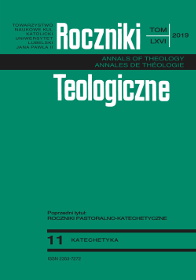Katecheza o Sądzie Ostatecznym na fresku z Sant' Agata dei Goti
Abstrakt
Wśród różnych form katechezy średniowiecznej wyróżnia się ikonografia, która ilustrowała podstawowe prawdy wiary i zachęcała do życia zgodnego z tym nauczaniem. Jednym z popularnych tematów ikonograficznych tego okresu był Sąd Ostateczny umieszczany zazwyczaj na tylnej ścianie kościołów po to, aby przypominać wychodzącym z kościoła ludziom o ich ostatecznym losie. Kwestie eschatologiczne cieszyły się zawsze dużą popularnością, bowiem dotyczą osobiście każdego człowieka. Oprócz zainteresowania wiernych treściami eschatologicznymi powodem powstawania przedstawień Sądu Ostatecznego była ich forma wizualna, dostępna dla każdego, nawet dla najsłabiej wykształconych. Jednym z tego typu dzieł jest fresk znajdujący się w miejscowości Sant'Agata dei Goti we Włoszech, który jest przedmiotem analizy w niniejszym opracowaniu. Omówione zostały główne treści przedstawione na fresku i ich forma. Wskazano na teologiczne znaczenie poszczególnych elementów ikonograficznych i ich zgodność z oficjalnym nauczaniem Kościoła. Podsumowując analizę fresku można stwierdzić, że stanowi on ważną formę ówczesnej katechezy, poprawnej teologicznie i mającej duże znaczenie pedagogiczne.
Bibliografia
Abbate F., La civiltà artistica, w: Le città nella storia d'Italia. Sant'Agata dei Goti, red. F. Abbate, I. Di Resta, Laterza, Roma−Bari 1984, s. 48-49.
Baschet J., Le sein d'Abraham. Un lieu de l'au-delà ambigu (théologie, liturgie, iconographie), w: De l'art comme mystagogie. Iconographie du Jugement dernier et des fins dernières à l'époque gothique, Poitiers 1996, s. 71-94.
Baschet J., Les justices de l'au-dela, les représentations de l'enfer en France et en Italie (12e-15e siècle), Rome 1993.
Campania, w: Storia dell'Arte italiana, s. 51-76.
Casagrande C., La moltiplicazione dei peccati. I cataloghi dei peccati nella letteratura pastorale dei secoli XIII-XV, w: La peste nera: dati di una realtà ed elementi di una interpretazione, Spoleto 1994, s. 25-47.
Cecchini G., Carli E., San Gimignano, Milano 1962.
Christe Y., Giudizio Universale nell'arte del medioevo, red. M.G. Balzarini, Milano 2000.
De Voragine J., Legenda Aurea, red. A.L. Vitale Brovarone, Torino 1995.
Dorini D., Giudizio Universale Sant'Agata dei Goti (Benevento) − Chiesa dell'Annunziata. Predica artistica, http://www.rudyz.net/apps/corsaro/filibuster.php?env=flb_giovyz&site=senzaconfini&id=A0000000090LRE (dostęp: 16.08.2019).
Frugoni Ch., Alberi (in paradiso voluptatis), w: L'ambiente vegetale nell'Alto Medioevo, Spoleto 1990.
Frugoni Ch., Lavorare all'Inferno, Bari 2004.
Grötecke I., Representing the Last Judgement: Social Hierarchy, Gender and Sin, „The Medieval History Journal” 1(1998), s. 233-260.
Il Santuario dei Ghirli in Campione d'Italia. Guida storico-artistica, Locarno 1984.
Jurkowlaniec G., Chrystus Umęczony. Ikonografia w Polsce od XIII do XVI wieku, Warszawa 2001.
Le Goff J., Długie średniowiecze, Warszawa 2004.
Le Goff J., Narodziny czyśćca, Warszawa 1997.
O'Reilly J., Studies in the Iconography of the Virtues and Vices in the Middle Ages, New York 1988.
Paolucci A., Denuncia sociale tra inferno e paradiso nel „Giudizo universale” di Sant'Agata dei Goti, „L'Osservtore Romano”, 4 czerwca 2014, s. 5.
Quirico T., A iconografia do Inferno na tradição artística medieval, „Mirabilia” 12(2011), s. 1-19.
Saporiti L., Il potere dello stemma araldico dell'Arma Christi, „Ricerche di S/Confine” 1(2010), nr 1, s. 3-34.
Scavizzi G., Nuovi affreschi del Quattrocento campano, „Bollettino d'Arte” 1962, s. 196-206.
Vorgrimler H., Storia dell'Inferno. Il sorgere e il fiorire dell'idea dell'aldilà dall'antica Babilonia ai nostri giorni, Casale Monferrato 1995.
Wegner H., Etimasia, w: Encyklopedia Katolicka, t. IV, red. R. Łukaszyk, L. Bieńkowski, F. Gryglewicz, Lublin 1995, kol. 1162-1166.
Copyright (c) 2019 Roczniki Teologiczne

Utwór dostępny jest na licencji Creative Commons Uznanie autorstwa – Użycie niekomercyjne – Bez utworów zależnych 4.0 Międzynarodowe.





